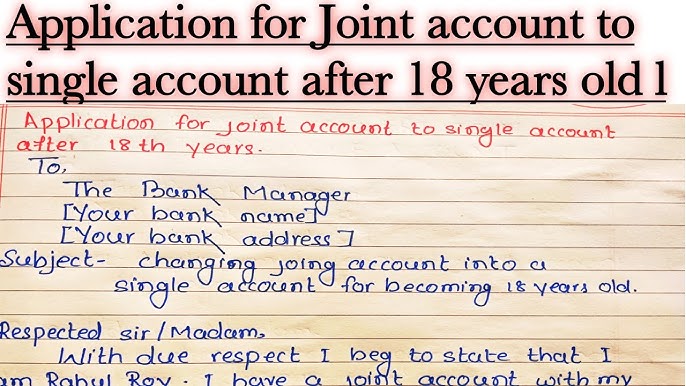Navigating Financial Transitions: A Comprehensive Guide on Converting a Joint Bank Account into a Single Account

Introduction:
Life is dynamic, and financial circumstances often evolve. One such change may involve transitioning from a joint bank account to a single account. Whether due to changes in relationships, financial independence, or a need for personal financial management, this comprehensive guide will walk you through the steps and considerations involved in converting a joint bank account into a single account. From understanding the implications to navigating the administrative processes, we aim to provide you with a roadmap for this financial transition.
Section 1: Assessing the Need for Change
1.1 Communication and Agreement:
- Open and honest communication is essential when considering this change.
- Ensure that both account holders are on the same page and agree on the reasons for converting the joint account into a single account.
1.2 Relationship Changes:
- Evaluate changes in relationships, such as divorce, separation, or changes in financial responsibilities.
- Consider the impact of these changes on joint financial management and whether a single account is more suitable.
Section 2: Understanding the Implications
2.1 Legal and Financial Implications:
- Research the legal and financial implications of converting a joint account into a single account.
- Be aware of any contractual obligations or potential fees associated with account changes.
2.2 Asset Division:
- In the case of relationship changes, understand the implications of asset division and how it may affect joint accounts.
- Seek legal advice if necessary to ensure a fair and legal separation of financial assets.
Section 3: Notifying the Bank
3.1 Contacting the Bank:
- Initiate the process by contacting your bank. Most banks offer various channels, including in-person visits, phone calls, or online platforms.
3.2 Account Holder Consent:
- Confirm whether the consent of both account holders is required to convert the joint account into a single account.
- Be prepared to provide identification and relevant documentation.
3.3 Bank Policies and Procedures:
- Familiarize yourself with the bank’s policies and procedures regarding account changes.
- Inquire about any forms or documentation required for this process.
Section 4: Closing the Joint Account
4.1 Settling Outstanding Transactions:
- Ensure that all outstanding transactions, including checks and direct debits, are settled before closing the joint account.
- Update recurring payments with the new account details if necessary.
4.2 Transferring Funds:
- Decide on the equitable division of funds in the joint account.
- Transfer the agreed-upon portion to the new single account.
4.3 Closing the Account:
- Follow the bank’s procedures for closing the joint account.
- Obtain confirmation in writing or digitally that the joint account has been closed.
Section 5: Opening a Single Account
5.1 Choosing a Bank:
- Evaluate different banks and their offerings to find a suitable institution for your new single account.
- Consider factors such as fees, services, and convenience.
5.2 Single Account Options:
- Select the type of single account that aligns with your financial needs, whether it be a savings account, checking account, or a combination of both.
5.3 Updating Personal Information:
- Provide the necessary identification and documentation to open the new single account.
- Update any personal information, such as address or contact details, during the account setup process.
Section 6: Updating Financial Accounts and Services
6.1 Direct Deposits and Withdrawals:
- Notify employers, pension providers, or any other entities of your new account details for direct deposits.
- Update billing information for automatic withdrawals.
6.2 Creditors and Loan Providers:
- Inform creditors and loan providers of your account change to avoid any disruptions in payments.
- Update account details for loans, mortgages, or credit cards.
6.3 Government Agencies:
- If applicable, notify government agencies of your account change, especially if you receive benefits or tax refunds directly into your account.
Section 7: Monitoring and Managing the Single Account
7.1 Budgeting and Financial Planning:
- Develop or revise your budget and financial plan based on the changes in your financial structure.
- Utilize personal finance tools or apps to track your spending and savings goals.
7.2 Emergency Fund and Contingencies:
- Ensure that your single account includes an emergency fund to cover unexpected expenses.
- Review and adjust your financial safety nets as needed.
Section 8: Seeking Professional Advice
8.1 Financial Advisors:
- Consider seeking advice from a financial advisor, especially if the transition involves complex financial scenarios or legal implications.
- An advisor can provide guidance on asset management, tax implications, and long-term financial planning.
8.2 Legal Counsel:
- In cases of relationship changes, consult with legal professionals to understand the legal implications of converting joint accounts into single accounts.
- Ensure that any legal documents, such as wills or powers of attorney, are updated accordingly.
Conclusion:
Converting a joint bank account into a single account is a significant financial transition that requires careful consideration and planning. By assessing the need for change, understanding the implications, and navigating the administrative processes, you can streamline the transition and ensure a smooth financial journey. Open communication, adherence to legal requirements, and a proactive approach to managing accounts will empower you to navigate this change successfully. Remember to seek professional advice when needed and, most importantly, prioritize financial well-being and stability.




